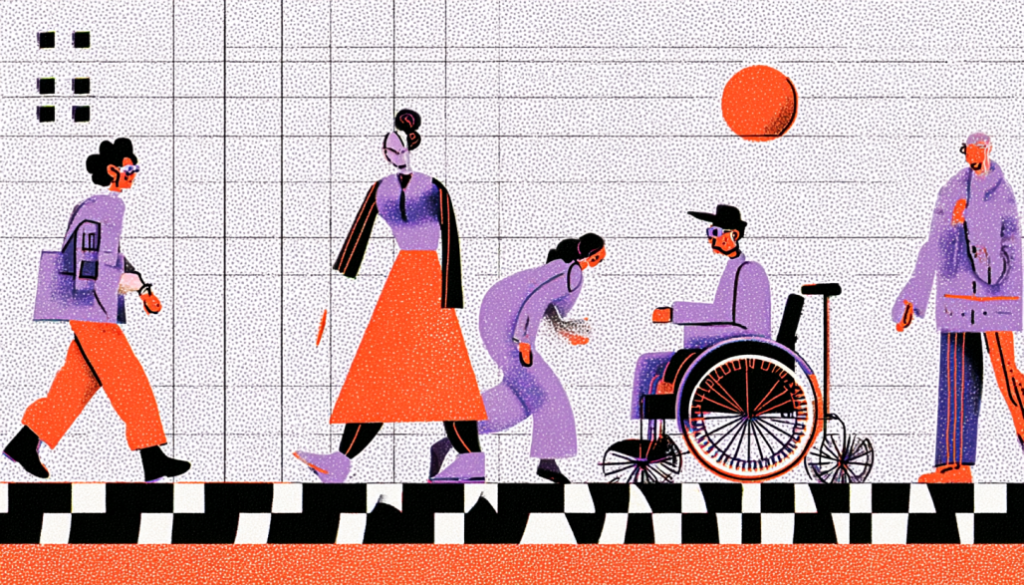Design for the Edges, and Everyone Benefits
Let’s get real—most of us design for the “average” user. However, the reality is that the “average” user does not exist. Every person who interacts with your product brings a different background, ability level, and expectation to the table. What happens if your design only caters to a narrow slice of the population? You’re not just leaving users behind—you’re losing business.
Inclusive design isn’t just about accessibility (though that’s a big part). It’s about crafting digital experiences that are flexible, respectful, and empowering for all users. It extends beyond individuals who speak a specific language, utilize specific devices, or perceive the world differently.
So, how do we shift our design mindset from “users like me” to “users unlike me”? Let’s dive in.
What Is Inclusive Design, Really?
It’s More Than Just Accessibility
Inclusive design is about proactively thinking of people who are usually left out. Rather than being a mere afterthought or tucked away in a compliance checklist, it should be incorporated from the outset of the design process.
Think of it like designing a ramp. Sure, it helps people in wheelchairs—but also parents with strollers, travelers with suitcases, and delivery workers. That’s the power of inclusive design: what starts as a solution for some ends up helping many.
Microsoft defines inclusive design as “a methodology born out of digital environments that enables and draws on the full range of human diversity.” That means diversity in ability, language, culture, gender identity, age, tech literacy—you name it.
Let’s break that down:
- Accessibility is about making sure people with disabilities can use your product.
- Inclusion is about ensuring everyone feels seen, heard, and respected.
- Equity is about removing barriers and giving users what they need to succeed—even if that looks different for each person.
Inclusive design lives at the intersection of all three. And no, it’s not a checkbox. It’s a mindset.

Why Inclusive Design Matters (and Why It Pays Off)
Exclusion Is Expensive. Empathy Is Profitable.
Do you still question whether investing in inclusion is worth the additional time and effort? Here’s a blunt truth: exclusion is bad for business.
Let’s look at the numbers:
- 1 in 6 people worldwide experience significant disability.
- Over 20% of U.S. adults read at or below a 5th-grade reading level.
- Aging populations are growing faster than any other demographic.
- Multilingual households are the norm in countless global cities.
If your product does not consider these realities, you may be overlooking significant groups of potential users. And guess what? They’re walking away.
But when you design inclusively:
- Your product becomes more flexible and resilient.
- Your brand builds trust and loyalty.
- You innovate in unexpected, delightful ways.
Remember curb cuts? Initially designed for wheelchair users, it now provides benefits to everyone, from skateboarders to parents hauling bags. That’s inclusive thinking in action.
Moreover, inclusive design contributes to improved SEO, increased engagement, and increased conversions. Google loves accessible, easy-to-navigate websites. So do your users.
The 7 Principles of Inclusive Design
A Blueprint for Designing With, Not Just For
Adding a few alt-text tags to your images is not the end of inclusive design. It’s a holistic approach. While there is no universally applicable formula, these seven principles serve as a solid foundation:
1. Provide Equal Access
Not everyone interacts with products in the same way. Offer multiple modes of interaction—keyboard, voice, and touch.
2. Recognize Diversity
People vary in background, age, language, literacy, and tech savviness. Design accordingly.
3. Offer Choices
Allow users to adjust font size, toggle animations, or choose their preferred language.
4. Prioritize Clarity
Simple, plain language beats jargon every time. Use clear labels, intuitive icons, and direct messaging.
5. Give Control
Don’t assume how people want to interact. Let them customize their experience to match their needs.
6. Support Error Recovery
Everyone makes mistakes. Make it easy to undo, edit, and fix.
7. Test With Real People
Design with, not for. Involve users from diverse backgrounds in usability testing from day one.
These principles aren’t just guidelines—they’re design accelerators. They keep your work grounded, human, and scalable.

Practical Tips for Making Your Product More Inclusive
Small Changes, Big Impact
Let’s get practical. How can you bring inclusive design into your next sprint without overhauling your entire roadmap?
Here are tactical tips you can apply today:
Use Alt Text, Always
Screen readers rely on it. But so do users on slow connections or those browsing with images off.
Write Like You Speak
Use plain language. Break long sentences. Avoid buzzwords. Talk to users, not at them.
Caption and Transcribe
Video content should have accurate captions. Audio? Add transcripts. It’s a win for accessibility and SEO.
Mind Your Color Choices
Don’t rely on color alone to convey meaning. Use high-contrast combos and check with tools like Stark or WCAG checkers.
Support Screen Readers
Use semantic HTML and ARIA labels. If you’re not familiar with those, it would be beneficial to learn about them.
Be Keyboard-First
Test your app without a mouse. Can you navigate, interact, and complete tasks?
Watch for Cognitive Load
Too much clutter, movement, or decision-making can overwhelm. Simplify.
Design for Different Literacies
Don’t assume every user is highly educated or fluent. Visuals, icons, and illustrations help bridge gaps.

Real-World Case Studies of Inclusive Design
Who’s Doing It Right?
Need inspiration? Let’s examine brands that are actively implementing these strategies.
Airbnb: Inclusive Filters
Airbnb added filters like “wheelchair accessible” and allowed hosts to detail accessibility features. This provided disabled travelers with more agency than just a checkbox.
BBC: Accessibility First
The BBC incorporates accessibility into every aspect of its design, including typography and keyboard navigation. Their internal tools even flag inaccessible design patterns.
Microsoft: Seeing AI
Microsoft has developed an app for the visually impaired that narrates the world around you. It reads text, identifies people, and even describes scenes. The app was developed by a blind engineer.
Duolingo: Literacy Levels
Duolingo uses simple UI and gamification to help even non-literate users navigate. Colorful icons, repetition, and short interactions support retention.
Target: Thoughtful UX
Their website and app are fully navigable with screen readers. What’s even more remarkable is their approach to accessibility. They do regular audits and user testing with people of various abilities.
These brands didn’t just meet accessibility standards—they embraced inclusive design as a driver of innovation and empathy.

How to Start Designing More Inclusively Today
Mindset Over Perfection
If you’re feeling overwhelmed, take a breath. You don’t need to do everything at once.
Inclusive design is a journey, not a sprint. Here’s how to ease into it:
- Start With Empathy: Ask whose voices are missing from your process. Go find them. Listen deeply.
- Audit What You’ve Got: Use tools like Axe, WAVE, or Lighthouse to see where your current product falls short.
- Prioritize the easy wins: Alt text, color contrast, and keyboard navigation—low effort, high impact.
- Make It a Team Sport: Educate your team. Bring inclusion to stand-ups, retros, and design critiques.
- Iterate Publicly: Tell users what you’re doing to improve. Ask for feedback. Build trust.
- Design for One, Extend to Many: Focus on an edge case—say, someone with low vision. Watch how it improves UX for everyone.
Here’s the truth: the more inclusive your product, the more human it becomes. And in a world flooded with apps and interfaces, that’s what truly stands out.
Inclusive Design Is the Future. Are You Onboard?
We’re not designing for machines—we’re designing for messy, beautiful, diverse humans. Humans come in various shapes, sizes, backgrounds, and abilities. Inclusive design isn’t about being politically correct. It’s about being radically empathetic—and smart.
By designing for the edges, you serve the center better. You future-proof your product. You build trust. You do better business.
So next time you’re wireframing, testing, or shipping that new feature, pause. Consider who could potentially miss out.
Then design like they matter. Because they do.






